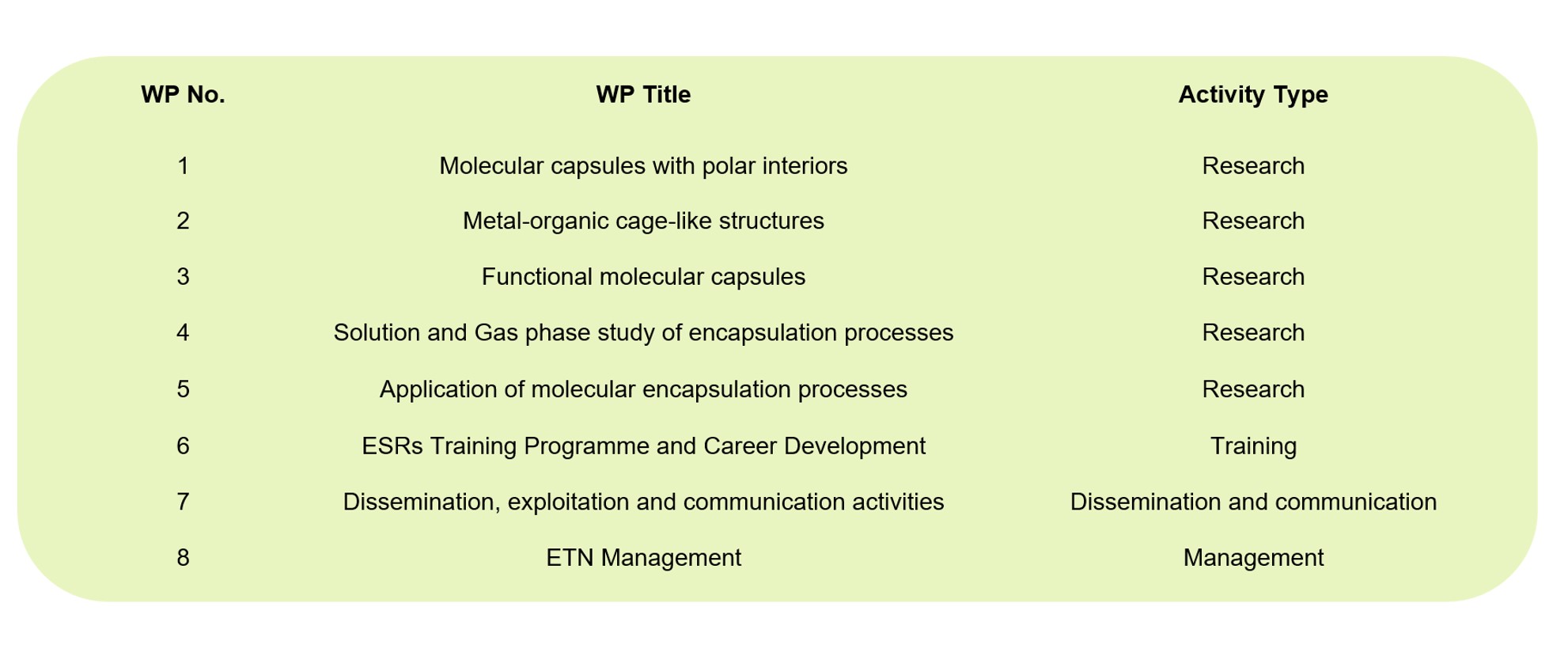NOAH SCIENTIFIC OBJECTIVE
The main scientific objectives (SO) of NOAH will focus on:
(SO.1). The synthesis of functional molecular containers based on different approaches (i.e. hydrogen-bond, dynamic covalent bonds, covalent bonds, and metal coordination bonds) and using a wide variety of building blocks (i.e. calixpyrrole, calixarene, porphyrin, arene ruthenium complexes, naphthalene derivatives, aromatic multidentate ligands, etc.).
(SO.2). The decoration of molecular containers with pendant ionisable groups or biomimetic motifs (e.g. peptides, pegylated chains), which will equip them with valuable additional features (i.e. water solubility, chiral environment, biocompatibility) for biochemical applications such as drug encapsulation, transport through cell membranes and drug delivery.
(SO.3). Equipping containers and/or guests with switchable functionalities (e.g. azo, spiropyran or hemithioindigo groups, protonable zwitterionic or redox groups, imine bonds etc.) that are addressable and responsive to external stimuli (e.g. light, electrons, pH, moisture, etc.) to gain control of the host-guest binding properties of the container and its assembly/disassembly processes.
(SO.4). The development of new tools and processes for the characterisation of supramolecular host/guest assemblies, their photo/electro induced functions and encapsulation processes (e.g. thermodynamic and kinetic characterisation of non-covalent interactions, studies of encapsulation complexes in the gas phase, molecular modelling and virtual screening of potential relevant guests, etc.)
(SO.5). Identifying and developing new applications of stimuli-responsive functional molecular containers, including their use in the formulation of new adhesives and coatings (catalysts encapsulation), in drug encapsulation and delivery (e.g. encapsulating relevant molecules in order to increase uptake in the body to the encapsulation of compounds for photodynamic therapy) or as recyclable systems for their application as vectors for controlled cell growth for skin regeneration (e.g. by supporting organic molecular containers into nanofibers ).
NOAH RESEARCH WORK PACKAGES
The NOAH research program has materialized into 5 Research Work Packages (WP1–WP5). Each Research WP contains a series of individual projects with specific objectives that can be grouped in three categories: Synthesis, Characterisation, and Applications covering all the previously depicted scientific objectives of NOAH SO.1–SO.5. In addition to the research work packages, we include three network-wide WPs (WP6–WP8) related to training activities in complementary skills and soft-skills, the dissemination, exploitation and communication of the obtained scientific results, and the overall management of the network.

NOAH RESEARCH OUTPUT
2019
Luis Martínez-Crespo, Jia Liang Sun-Wang, Pedro Ferreira, Chiara F. M. Mirabella, Gemma Aragay, Pablo Ballester “Influence of the Insertion Method of Aryl-Extended Calix[4]pyrroles into Liposomal Membranes on Their Properties as Anion Carriers” Chem. Eur. J. 2019, 25, 4775 – 4781. pdf
Daniel Sánchez-Resa, Laetitia Schoepff, Ryan Djemili, Stéphanie Durot, Valérie Heitz, Barbara Ventura “Photophysical properties of porphyrinic covalent cages endowed with different flexible linkers” J. Porphyrins Phthalocyanines 2019, 23, 841-849. pdf
2020
2021
Amy Edo-Osagie , Daniel Sánchez-Resa, Dylan Serillon, Elisa Bandini, Christophe Gourlaouen, Henri-Pierre Jacquot de Rouville, Barbara Ventura, Valérie Heitz, Synthesis, electronic and photophysical properties of a bisacridinium-Zn(II) porphyrin conjugate. C. R. Chimie 2021 doi: 10.5802/crchim.100. pdf
Dylan Serillon, Carles Bo, Xavier Barril “Testing automatic methods to predict free binding energy of host–guest complexes in SAMPL7 challenge” J. Comput. Aided Mol. Des. 2021, 35, 209-222. pdf
Pedro Ferreira, Giulia Moncelsi, Gemma Aragay, Pablo Ballester, Hydrogen-Bonded Dimeric Capsules with Appended Spiropyran Units: Towards Controlled Cargo Release. Chem. Eur. J. 2021. doi: 10.1002/chem.202101643. pdf